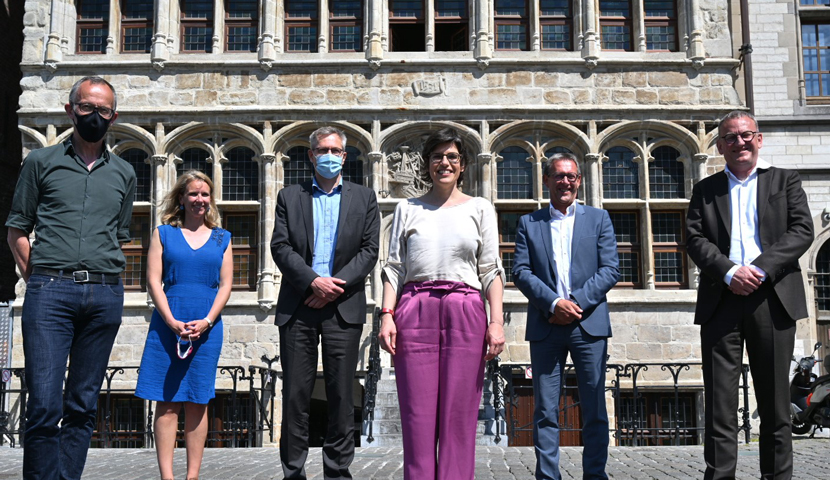Hydrogen and carbon backbone in North Sea Port
Federal Energy Minister Tinne Van der Straeten and Fluxys Belgium, ArcelorMittal Belgium and North Sea Port join forces on infrastructure
North Sea Port, Fluxys Belgium, ArcelorMittal Belgium and Federal Energy Minister Tinne Van der Straeten are joining forces to develop a network of pipelines for hydrogen, CO2 and heat in the port area. This was agreed during a visit by the minister to North Sea Port on Wednesday 2 June.
This hydrogen, CO2 and heat ecosystem is a new step in the energy transition and efforts to reduce CO2 emissions in the Belgian part of North Sea Port. These parties – the energy minister, port authority, gas infrastructure company and industry player – are joining forces and combining their expertise to vigorously pave the way towards carbon neutrality in the region and throughout the country.

Federal Energy Minister Tinne Van der Straeten: "With the agreement signed today, hydrogen is no longer a distant dream but a nearby reality. Our unique location in the heart of Europe – at an energy crossroads right in the middle of multiple industrial clusters – makes Belgium an ideal country for fully exploiting the benefits of hydrogen. Belgium has a lot of heavy industry, which accounts for nearly 30% of total CO2 emissions, and it is precisely that sector that is best suited for switching to hydrogen in order to, among other things, produce carbon-free or green steel. Green hydrogen is playing a crucial role on the path towards a carbon-neutral economy."
Pipelines for hydrogen, CO2 and heat
The aim is to build pipelines for hydrogen, CO2 and heat in the Belgian part of the cross-border port area of North Sea Port. Via these pipelines, companies that produce, import, transport and store hydrogen, CO2 and heat will be able to connect with companies that use these as raw materials in their production processes. As a result, supply is matched with demand – a crucial step in the development of a Belgian hydrogen hub. The new network in the Belgian part of North Sea Port will be connected to the pipeline network in the Netherlands, which is critically important for industry in and around the cross-border port zone.
Connection to the national grid
This pipeline infrastructure in the port zone will in turn be connected to Fluxys' national grid. "With a view to becoming carbon-neutral, Belgium not only needs renewable electricity, but also large amounts of hydrogen and solutions in order to reuse and store CO2. For this purpose, both molecules must be able to circulate freely between producers and customers. As an independent gas infrastructure company, Fluxys Belgium is working to this end together with industry, ports, authorities and other stakeholders," says Fluxys Belgium CEO Pascal De Buck. "Our collaboration with North Sea Port and ArcelorMittal Belgium is an important step forward, neatly dovetailing with our market consultation to find out which hydrogen and CO2 projects they currently have in progress, what their needs are and how we can respond to them. The market's response to our consultation has been especially broad and positive. With this information, we will go back to the market in order to build bridges between demand and production. In this way we lay the foundation for the transport of the molecules for a carbon neutral future."
Manfred Van Vlierberghe, CEO ArcelorMittal Belgium: "ArcelorMittal Gent is a world leader in energy efficiency and CO2 emissions per tonne of steel. We want to further expand this leadership position in the future by gradually replacing fossil carbon with green and circular carbon and hydrogen. We are also increasingly replacing 'fresh' raw materials with waste materials and transforming our own waste materials into new raw materials. In this way, we are evolving into the heart of a growth model in a circular ecosystem that is not only becoming carbon neutral, but also waste neutral. An ecosystem that also connects and strengthens companies and industries."
Federal recovery plan
Energy Minister Van der Straeten: "Chemicals and steel are the country's largest industrial CO2 emitters. The ArcelorMittal plant in Ghent accounts for 8% (9.6 million tonnes of CO2) of Belgium's total CO2 emissions. Greening our industry is therefore essential. In the steel industry, 1 tonne of hydrogen can save up to 26 tonnes of CO2. With that in mind, in the federal recovery plan I have earmarked €95 million for hydrogen and for building a CO2 backbone in our industrial clusters. We are going to invest in projects that will ensure that our heavy industry becomes greener in the short term while also remaining competitive. This is an essential piece of the puzzle for meeting our climate goals as a country."
Cross-border network is an extra asset for North Sea Port investors
Industrial players in this cross-border economic area can use the pipeline network to transport their CO2, hydrogen and heat. This is important for ArcelorMittal Belgium, for example, so that it can reduce CO2 emissions during the production of (green) steel, which it in turn supplies as a raw material for other companies. The hydrogen and CO2 infrastructure will also be needed to enable the reuse of CO2, such as in projects like North-C-Methanol where an industrial consortium including ENGIE will combine green hydrogen with CO2 for the production of green methanol. The cross-border nature of hydrogen infrastructure is important when it comes to linking up wind farms in Zeeland, whereby wind energy is used to produce hydrogen.
North Sea Port CEO Daan Schalck: "Thanks to its unique location, North Sea Port is ideal for connecting CO2, hydrogen, heat and high-voltage infrastructure across borders. This new infrastructure is an extra asset for encouraging additional sustainable, circular industry to set up operations in the port zone. As a result, North Sea Port is able to grow and develop more strongly as both a sustainable energy port and a circular port."
- Please feel free to contact us
- Thierry VervenneTim De Vil